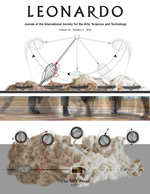Leonardo (journal)
 | |
| Discipline | Arts |
|---|---|
| Language | English |
| Edited by | Roger F. Malina |
| Publication details | |
| History | 1968–present |
| Publisher | MIT Press (United States) |
| Frequency | 6/year (including Leonardo Music Journal) |
| Standard abbreviations | |
| ISO 4 | Leonardo |
| Indexing | |
| ISSN | 0024-094X (print) 1530-9282 (web) |
| JSTOR | 0024094X |
| OCLC no. | 1755782 |
| Links | |
Leonardo is a peer-reviewed academic journal published by the MIT Press covering the application of contemporary science and technology to the arts and music.[1]
History[]
Leonardo journal was established in 1968 by artist and scientist Frank Malina in Paris, France.[2] Leonardo has published writings by artists who work with science- and technology-based art media for 50 years.[3][4] Journal operations were moved to the San Francisco Bay Area by Frank's son Roger Malina, an astronomer and space scientist, who took over operations of the journal upon Frank Malina's death in 1981. In 1982, the International Society for the Arts Sciences and Technology (Leonardo/ISAST) was founded to further the aims of Leonardo by providing avenues of communication for artists working in contemporary media. The society also publishes Leonardo Music Journal, the Leonardo Electronic Almanac, Leonardo Reviews, and the Leonardo Book Series. All publications are produced in collaboration with the MIT Press.
Other activities of the organization include an awards program and participation in annual conferences and symposiums such as the Space and the Arts Workshop and the annual College Art Association conference. Leonardo has a sister organization in France, the Association Leonardo, that publishes the Observatoire Leonardo website. While encouraging the innovative presentation of technology-based arts, the society also functions as an international meeting place for artists, educators, students, scientists and others interested in the use of new media in contemporary artistic expression.
The aims of the organization include the documentation of personal and innovative technologies developed by artists, similar to the way in which findings of scientists are documented in journal publications.[5]
See also[]
- New Media
- Caterina Verde, contributing artist
References[]
- ^ About Leonardo
- ^ History of Leonardo
- ^ Thomas, Jessica (2018-12-12). "Arts & Culture: A Journal for the Polymath". Physics. 11: 128. Bibcode:2018PhyOJ..11..128.. doi:10.1103/Physics.11.128 (inactive 31 May 2021).CS1 maint: DOI inactive as of May 2021 (link)
- ^ Kunzru, Hari (1996-06-01). "Art and Invention". Wired. ISSN 1059-1028. Retrieved 2019-08-08.
- ^ Leonardo de Cardoso: Visual Music: An Ethnography of an Experimental Art in Los Angeles, Master's Thesis, University of Texas at Austin, May 2010, p. 39
External links[]
- Publications established in 1968
- MIT Press academic journals
- English-language journals
- Arts journals
- Bimonthly journals
- Academic journals associated with learned and professional societies
- 1968 establishments in France
- Art journal stubs